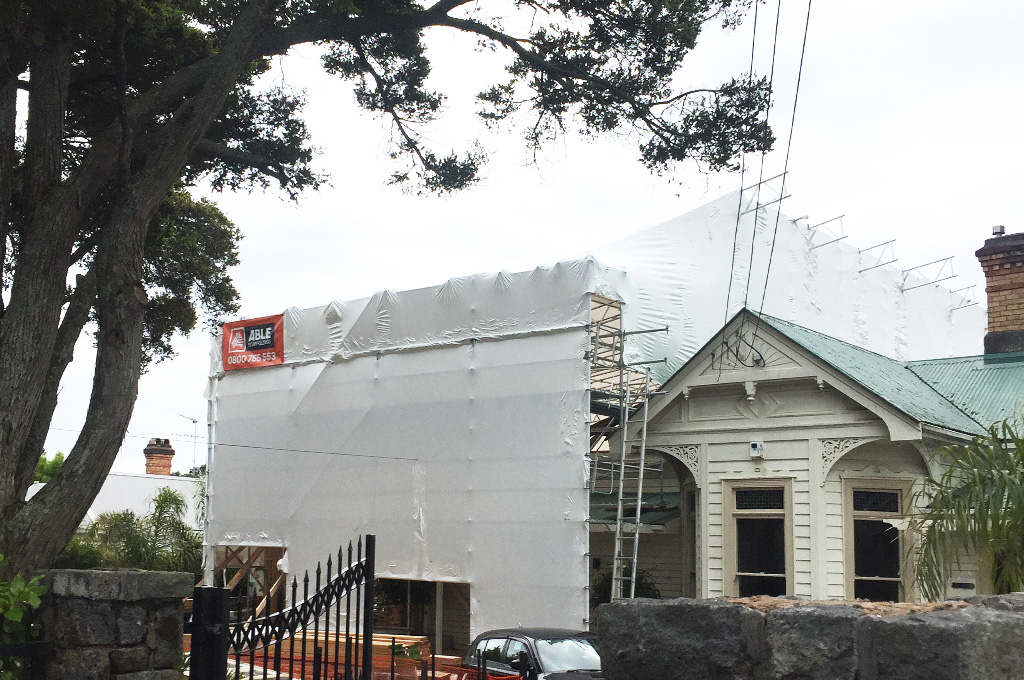Shrinkwrapping
It is no secret that Auckland’s climate is unpredictable and increasingly extreme. The best way to avert expensive delays or structural damage caused by weather events is to shrinkwrap your home, building or work site.
Shrinkwrapping is a must-do for re-clads, asbestos removal, leaky building upgrades and large-scale roofing jobs, too.
With Able’s shrinkwarp service we can safeguard your entire project and help ensure your maintenance or build schedule comes in on time, regardless of the elements.
Avoid the stress and potential costs by keeping your contractors and property, safe and dry.
Protect your site now.

Finding solutions for the biggest single-use soft plastic waste item of all Shrinkwrapping
Sarah Heeringa - Aug 11 2023
Many of us diligently wash and dry our clean soft plastic household waste items, collecting them in bags ready for dropping off at the supermarket or other collection point.
On our way through the neighbourhood we might pass a new build, or a house being refurbished. Typically, there will be screeds of plastic wrapping the building – much of which likely goes straight to landfill.
Could the shrink wraps on buildings be the largest of all the single-use soft plastic waste items?
Plastic shrink-wrap has been the go-to option in the construction industry for the past twenty years or so.
Its use proliferated during the leaky building era when many buildings needed to be re-clad says Mark Roberts, a senior waste planning specialist at Auckland Council.
The Waiōrea Community Recycling Centre in Western Springs opens today. Its refurbishment was the perfect opportunity for Roberts and the council team to trial a shrink-wrap alternative.
Building shrink wrap is generally made with low density polyethylene, or LDPE, says Dr Terri-Ann Berry, a professor of environmental engineering and director of the Environmental Solutions Research Centre.
“This plastic is an incredibly valuable resource. It takes a lot of energy and carbon emissions when making plastic into products. We should be thinking of alternatives to just disposing it in landfill, including options for reuse or recycling.”
Construction and demolition waste currently makes up to half of all waste going to landfill. In Auckland alone, plastic waste going to landfill can equate to as much as 25,000 tons every year, says Berry.
Changing our practices around building plastic could make a significant difference.
A new experiment for an old building
The Waiōrea Community Recycling Centre in Western Springs opens today as a flagship community resource recovery and learning hub for inner-city Auckland suburbs.
Making the 1930s heritage building – and former Chamberlain Park Golf Club – fit it for its new purpose required an extensive refurbishment over the past months, including remedial work to the building’s roof and parapet.
continued...
The recycling centre is a partnership between the MPHS Community Trust and Auckland Council, and given the project’s aim of zero waste to landfill by 2040, the rebuild presented a perfect opportunity to trial some new ‘green build’ construction practices.
For one thing, Roberts was determined shrink-wrap would not be used to cover the building.
“Shrink wrap has a lot of redeeming features, such as productivity benefits and keeping the weather out,” says Roberts. “But despite assurances it is often recycled, I still see this plastic regularly ending up in landfill.”
Roberts says there are some recycling options for the plastic, but once it’s dirty, its recycling potential falls.
“At some point someone has to say no to shrink wrap,” he says. “As Waste Solutions at the council we decided we’d be the ones to say no.”
“We don’t have infinite resources, nor a bottomless pit for waste. If we’re asking industry to change business-as-usual practices, we as the council must be innovative and start to set the example.”
After working with developers on potential solutions to this sector-wide issue, Roberts challenged the project manager and contractors for the recycling centre refurbishment, to find a more sustainable alternative.
Consideration was given to various options, including tarpaulins, before they opted for the Keder system. This is a system involving fabric stretched over rails that allow it to slide into place. It can be used for mounting temporary structures, large-scale banners and signage.
The product keeps the weather out, is more environmentally friendly and less unsightly than shrink wrap, says Roberts. The system itself is flexible with a variety of uses including marquees, tents, and awnings. The key feature being that it is designed to be taken down and reused multiple times.
Roberts says the Keder system is slightly more expensive than the single use plastic option, but not hugely so. And when the job is done you can roll it back up and use it again on the next job.
Stuff Newspaper Article - https://www.stuff.co.nz/environment/climate-news/132719840/finding-solutions-for-the-biggest-singleuse-soft-plastic-waste-item-of-all
The former Chamberlain Park Golf Club in Western Springs, Auckland, has been refurbished to create the new Waiōrea Community Recycling Centre.

